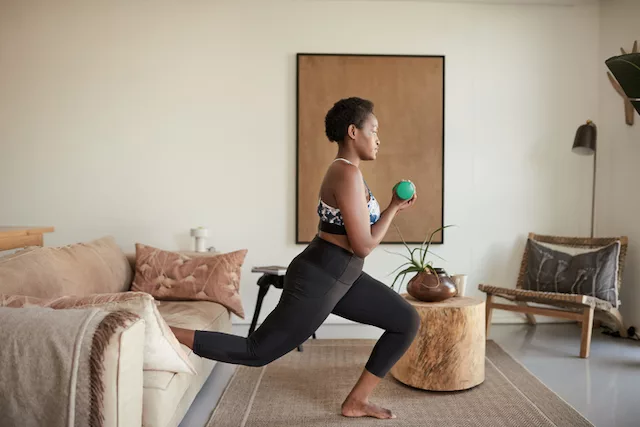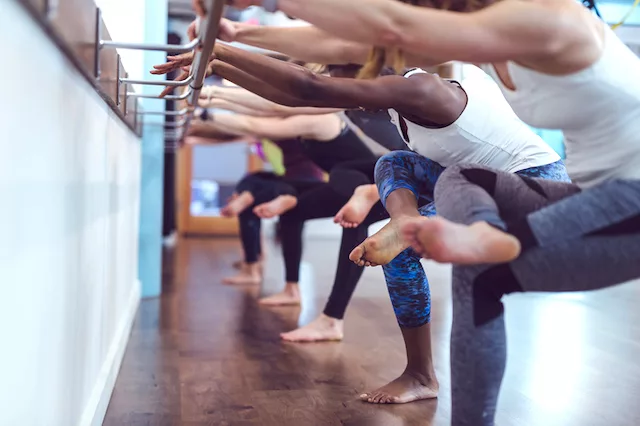Interested in trying out this workout trend? See what health and fitness pros really think about the viral 3-2-8 method.
It seems that every day, like clockwork, there’s a new wellness trend taking over TikTok. Admittedly, I’ve never logged onto the app, yet these fads and hacks tend to get on my radar one way or another.
One such trend gaining momentum on the fitness front is the 3-2-8 method. At first glance, it seems solid and compelling enough… especially since two of my own preferred fitness modalities are Pilates and walking. But what do health and fitness pros—and research at large—have to say about it?
What Is the 3-2-8 Method?
Britain-based Pilates and barre instructor Natalie Rose, aka @natalieroseuk, kickstarted the viral fitness trend. The 3-2-8 method consists of three elements, guided by its namesake numbers, that are meant to be completed over the course of a week:
- 3 = 3 days of strength training
- 2 = 2 days of Pilates or barre
- 8 = an average of walking 8,000 steps per day
It’s more of a framework than a detailed list of to-dos. For instance, there’s no specific outline on strength training moves you should do, how heavy any weights should be (though you’re meant to progressively level up both the weights, reps, and/or intensity of the strength training sessions), how long each workout should take, etc.
Another interesting element of the 3-2-8 barre Pilates method is that the low-impact exercises should be carried out on days when you’re menstruating—as well as on active recovery days. (Of course, you can go ahead and try the 3-2-8 workout plan yourself if you don’t menstruate.)
In one of Rose’s TikTok videos, she suggests that her viral fitness trend will allow you to “stop trying to train against your menstrual cycle and start to train with it.” The purported results of following Rose’s protocol? “Now your period has regulated. Inflammation has reduced & you’ve dropped 10lbs,” the text overlay reads. But does it really check out? More on this soon to come.

Benefits of the 3-2-8 Method
Strength Training
First, let’s start with strength training. You’ll be hard-pressed to find a health or fitness professional who’d advise against incorporating resistance training into your welness regimen.
After all, the benefits of strength training go well beyond getting ripped. Strength training can also help:
- Burn fat
- Rev up calorie burn and boost metabolism
- Support weight management (or weight loss, if complemented by the right dietary protocol)
- Increase bone mass, which is especially important for healthy aging since we lose 1 percent of bone mass annually from age 40 onwards
- Improve cognitive function
- Boost your mood via endorphins
- Promote self-esteem, confidence, and a sense of accomplishment
Simply put, the mind-body benefits of strength training are too good to pass up. If you don’t often engage in workouts that offer resistance from your own body weight or the likes of kettlebells and dumbbells, the 3-2-8 method could bring your fitness regimen (and well-being at large) to the next level.

Pilates and Barre
According to Danielle Burdick English—a certified Pilates and barre instructor who teaches at Speir Pilates and Equinox, both in West Hollywood, California—these two low-impact fitness modalities are highly accessible while still being challenging. “They have something to offer every individual body, with benefits including increased range of motion, strength, flexibility, balance, stability, core strengthening, and improved posture,” she shares.
The 3-2-8 method allows you to choose your own adventure here. You can try out anything from a mat Pilates video, a barre burn class, or a session on a Pilates reformer. Burdick English, who regularly teaches reformer classes, says that the use of the machine “is essentially resistance training designed to target specific muscle groups in an extremely efficient manner.” She adds that it pairs exceptionally well with standard weight-based workouts. “Pilates really fills in the gaps that standard strength training can neglect, which typically only target the larger muscle groups,” she shares.
Burdick English notes that she might be biased given her background, but she wholehearted vouches for integrating barre—and especially Pilates—into your workout regimen. “After teaching Pilates to many different bodies of all abilities over the last 13 years, I can’t deny its effectiveness and truly transformative qualities,” she continues. “Anything you’d hope to do with your physical body, Pilates helps you do it better.”
8,000 Steps a Day
Walking is one of the simplest and most rewarding ways to move your body. Even brief yet consistent walks are linked to benefits such as:
- Lower health risks associated with a sedentary lifestyle
- More energy and stronger mental health
- Improved sleep quality
- Faster digestion
- Protection against cognitive decline
Again, the 3-2-8 method advocates for logging an average of 8,000 steps per day… but is there truly any magic to this number? While 10,000 steps is an oft-cited daily walking goal, it turns out that you can still reap impressive perks by cutting that number down a bit.
Per a March 2023 study in the Journal of the American Medical Association, adults over the age of 20 who took at least 8,000 steps only one or two days per week showed “substantially lower all-cause and cardiovascular mortality risk.” Cue the mic drop… namely for those who live sedentary lifestyles and/or lack motivation to hit the pavement.
“These results are so important and impactful,” says cardiologist Suzanne Steinbaum, DO, who often “prescribes” gentle movement like walking to her patients. “Walking can be an easy way to improve your health and well-being by reducing stress, increasing vitality, and as found here, preventing heart disease.” To put it into context, this study shows that walking only a couple times a week “can potentially add 10 years to your life,” Dr. Steinbaum continues.
And yes, the 3-2-8 workout plan calls for 8,000 steps each day. This daily quota can only amplify your wellness game even further, says OB-GYN Wendy Goodall McDonald, MD, FACOG, as it calls for “intentionally avoiding a sedentary lifestyle.”

Potential Cons of the 3-2-8 Method
Thus far, it appears as though the 3-2-8 method is a TikTok trend that health pros can truly rally behind. That said, there are a few minor caveats to note:
It Can Lack Adequate Cardio
Despite the positive findings demonstrated by the study above, the CDC recommends that adults get at least 150 minutes of moderate-intensity cardio, or 75 minutes of intense cardio, per week. (They also recommend two days of strength training, so the 3-2-8 workout ticks that box.) That said, it could be worth reaching your 8,000 steps on a challenging hike or via an incline on a treadmill, or doing an additional cardio workout or two per week.
Note: Burdick English mentions that Pilates and barre classes—whether online or IRL—can also have a more intense cardio component to them; so can walking at a vigorous pace.
The Menstrual Health Claims Lack Solid Evidence
Rose’s claim that the 3-2-8 workout will regulate your period doesn’t get the all-clear from Dr. Goodall McDonald. (After all, it hasn’t been studied and measured in a clinical setting.) That said, the OB-GYN doesn’t discount Rose’s method entirely as part of a generally healthy lifestyle. “She’s on the right track, though I’m not sure that her particular exercise recipe needs to be as closely followed,” she shares. “We know that exercise is cumulative, so whether a person exercises 45 minutes three times per week, 2 hours and 15 minutes once per week, or 30 minutes five days per week, the benefits are practically the same.”
P.S. If you’re seeking a fitness regimen that may help on the hormonal and menstruation front, check out HUM’s guide to cycle syncing exercise. There, you’ll find when it could be best to schedule your weight lifting sessions, Pilates or barre classes, and walks. (These vary by menstrual cycle phases, so it doesn’t precisely align with the 3-2-8 workout plan)
The Takeaway
All things considered, the 3-2-8 method is definitely one of the better TikTok trends circulating on the fitness front. This rings especially true if you tend to stick to only one fitness modality and could use a new framework to switch things up—and even more so if you’re not highly active to begin with.
“I appreciate cross-training and believe the mix of circuit training with explosive movements and heavier weights three times a week, low-impact strength training twice a week, and walking 8,000 steps absolutely creates a very strong, capable, healthy, and balanced body,” Burdick English shares. “Any movement your body enjoys is of merit. I also love a holistic approach that encourages participants to cross-train across multiple disciplines, as the 3-2-8 method does.”
Build Your Supplement Routine
Take The HUM Quiz
The post Is TikTok’s 3-2-8 Workout Method a Perfect 10? appeared first on HUM Nutrition Blog.
---------------------------
By: Michele Ross
Title: Is TikTok’s 3-2-8 Workout Method a Perfect 10?
Sourced From: www.humnutrition.com/blog/3-2-8-method/
Published Date: Fri, 21 Apr 2023 03:08:20 +0000
Read More
Did you miss our previous article...
https://prohealthsciences.com/supplements-and-vitamins/three-healthy-meals-from-the-chipotle-menu-that-are-rd-approved
 General Health and WellnessFitness and ExerciseSupplements and VitaminsPandemic NewsVideosPrivacy PolicyTerms And Conditions
General Health and WellnessFitness and ExerciseSupplements and VitaminsPandemic NewsVideosPrivacy PolicyTerms And Conditions
